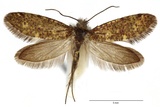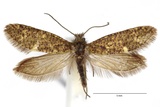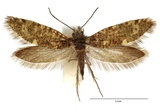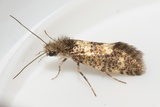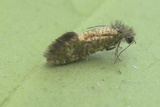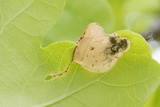Dyseriocrania subpurpurella (Haworth, 1828) Species
Last modified: Dec. 16, 2025, 6:29 p.m.
A common species throughout Belgium.
Details
- Classification
- Family: Eriocraniidae > Genus: Dyseriocrania > Species: Dyseriocrania subpurpurella
- Vernacular names
- Eikenpurpermot (NL), Common Oak Purple (EN), Eichen-Purpurmotte (DE)
- Synonyms
- Dyseriocrania fastuosella (Zeller, 1839) and Dyseriocrania donzelella (Duponchel, 1839)
- First mention in Belgium
- De Sélys-Longchamps E. 1844. Énumération des insectes Lépidoptères de la Belgique. — Mémoires de la Société royale des Sciences de Liége 2: 1–35. On page 24 (as Adela donzelella Dup.). view page
- Status
-
Native
Distribution
Caterpillar
The caterpillar is white with a pale-brown head.
Mine
The mine starts as a narrow, short corridor that is almost completely filled with black frass. Soon this corridor turns into an elongated whitish blotch mine that lies on the leaf edge.
See also bladmineerders.be
Cocoon/pupa
Pupation takes place in the ground in a silk cocoon.
Bionomics
The females deposit their eggs in the young leaves by means of a piercing ovipositor. When these young leaves grow, these piercings remain visible as gaps in the leaves. Initially, the mines consist of a narrow, short corridor that is almost completely filled with black frass but soon changes into an elongated whitish blotch mine that lies on the leaf edge. In these blotch mines the frass, typical with Eriocraniidae, lies in long threads. The caterpillars hibernate as a pupa in a silk cocoon in the ground.
The adults can be observed resting on trees and come also to light.
Flight periods
The adults fly in April and May.
Observed on
- Host plant (genera):
- Quercus
The larva lives on different species of Quercus.
